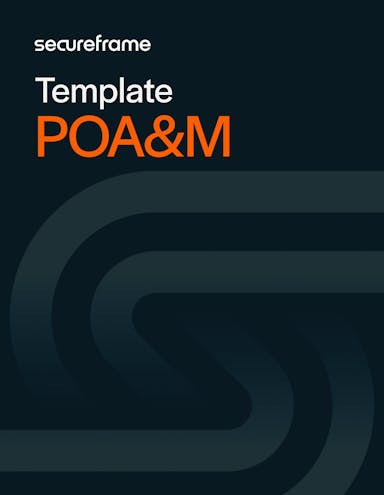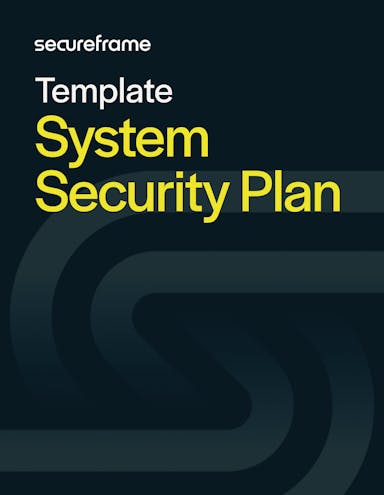
How to Write a System Security Plan for CMMC + SSP Template
Emily Bonnie
Senior Content Marketing Manager
Rob Gutierrez
Senior Cybersecurity and Compliance Manager, CISA, CCSK, CMMC RP
If you're pursuing compliance with the Cybersecurity Maturity Model Certification (CMMC), creating a System Security Plan (SSP) is one of the most important steps in preparing for an assessment. But what exactly goes into an SSP, and how do you write one? This guide will break it down for you, explaining this critical document’s purpose, key components, and the steps needed to draft a compliant SSP. We’ll also provide practical tips and a downloadable template full of examples to get you started and make the whole process easier.
Let’s dive in!
What is a System Security Plan?
A system security plan (SSP) is like a detailed blueprint that outlines how your organization protects sensitive data — in the case of CMMC, specifically, information related to government contracts, such as Controlled Unclassified Information (CUI) and/or Federal Contract Information (FCI).
Maintaining an SSP is required for CMMC 2.0 compliance at Levels 2 and 3. It shows you’ve carefully considered and documented how you keep your systems secure and satisfy each of the framework’s cybersecurity requirements.
Here’s a general overview of what an SSP covers:
- What you’re safeguarding: It outlines which parts of your systems (hardware, software, networks, etc.) are in scope and how they interact, like a map of your digital environment.
- How you protect it: The SSP spells out the specific security measures and processes you’ve put in place to meet requirements, such as data encryption and access controls.
- Who’s responsible: It identifies who’s in charge of each part of your security efforts, so there’s no confusion about roles and responsibilities.
- How you connect to external systems: The SSP also explains how you connect to any outside systems, such as a cloud service provider, and how you make sure those connections are secure.
The SSP is critical because when you’re going through a CMMC assessment, it’s one of the first documents the assessors will look at. It’s your chance to show them, in detail, how you’ve met security requirements.
Recommended reading

What CMMC Documentation Is Required for Compliance?
What to include in a CMMC System Security Plan
An SSP typically includes sixteen sections, building a comprehensive view of your system’s security architecture, risk management practices, and operational procedures.
By understanding what goes into an SSP, you’ll be better equipped to create one that satisfies CMMC compliance requirements and helps you strengthen your overall security posture. Here’s an outline of the key sections, their purpose, and what information to include in each.
1. Introduction and overview
The first section sets the stage by explaining why the SSP exists and what it covers, emphasizing your organization’s commitment to protecting CUI and complying with CMMC 2.0 requirements. It provides stakeholders and assessors with a clear understanding of the document’s purpose, its relevance to CMMC 2.0, and the scope of the system being assessed.
2. System boundaries
The next section defines what is included in the scope of the SSP. A well-defined system boundary identifies all system components that handle CUI and/or FCI. This includes physical devices like servers, workstations, and network equipment, as well as logical components such as software applications, databases, and cloud environments. It also explains how data flows between these components and how it interfaces with external systems or third-party service providers.
What to include:
- A description of the physical and logical boundaries of the system
- A list of all components (e.g., servers, applications, cloud environments, networks)
- Diagrams showing how the system interacts with external entities
3. System description
This section describes the system’s purpose, functionality, and operational environment in detail, giving assessors and stakeholders a clear understanding of how the system fits into the organization’s broader operations.
A well-written system description helps assessors and stakeholders understand not just what the system is, but also how it operates and where potential security risks might exist — essential for evaluating how well the organization has implemented security controls and how those controls align with the overall goals of CMMC compliance.
What to include:
- Overview of the system architecture
- Operating environment (e.g., on-premises, cloud, hybrid)
- Key functionalities and intended uses of the system
4. Roles and responsibilities
The Roles and responsibilities section ensures accountability by assigning specific responsibilities for implementing, managing, and maintaining security controls. It also clarifies the chain of command and escalation paths for any security issues, ensuring that everyone involved understands their role for efficient decision-making and response.
This section is crucial because it provides assessors with evidence that your organization has a structured and strategic approach to managing its security obligations. By assigning specific duties, your organization demonstrates its commitment to ensuring that critical security and compliance tasks are performed reliably and consistently.
What to include:
- List of key roles (e.g., System Owner, Security Officer, IT Administrator)
- Responsibilities for each role related to security controls and configuration management
5. Security requirements implementation
This section is typically the longest in an SSP. It demonstrates your level of compliance by explaining how you’ve implemented each CMMC 2.0 security requirement, providing a roadmap for assessors and internal teams to verify that all necessary controls are in place. For Level 2 compliance, this means addressing all 110 controls outlined in NIST SP 800-171, and for Level 3, the additional controls from NIST SP 800-172.
Each control must be described in detail, including the specific policies, procedures, technologies, and practices in place to meet the requirement. For example, explaining access control might involve describing multi-factor authentication, role-based access controls, and periodic access reviews.
What to include:
- A table or detailed description of each requirement (aligned with NIST SP 800-171 rev 2 for CMMC Level 2 and NIST 800-171 and NIST 800-172 for CMMC Level 3)
- The specific policies, procedures, and controls in place to satisfy each requirement
6. Interconnections
This next section documents the points where your system connects to any external systems, such as cloud service providers, partner organizations, third-party vendors, or external applications. Each connection should be documented in detail, including the nature of the interaction, the type of data exchanged, and the security controls in place to protect these exchanges.
This level of detail shows assessors that your organization has carefully evaluated third-party risks and taken the appropriate steps to reduce exposure to external threats.
What to include:
- Details of how data flows between your system and external entities
- The security measures in place for each connection, such as firewalls or encryption
- How third-party vendors are assessed for compliance with security requirements
- How service-level agreements (SLAs) are enforced to uphold these standards
7. Risk management
The Risk management section explains how your organization identifies and addresses potential risks. The process begins with a risk assessment, where potential vulnerabilities, threats, and impacts are identified and documented. This includes analyzing the likelihood of threats like data breaches or system failures and the potential impact of those events.
Mitigation strategies are also outlined for each risk, including implementing technical controls, such as firewalls or encryption, and administrative controls, such as access policies or employee training programs. This section may also describe how risks are continually monitored and reassessed to recognize new threats and adapt to any changes in your organization’s environment.
What to include:
- Risk assessment findings
- Mitigation strategies for identified risks
- Risk register
8. Access control
The Access control section describes the policies and procedures your organization has in place to ensure that only authorized users can access sensitive data, such as multi-factor authentication and role-based access controls.
This section also explains how access is monitored and reviewed. For example, it may describe processes for regularly auditing user permissions, promptly revoking access when employees leave or change roles, and identifying unusual login activities that might signal unauthorized access attempts.
What to include:
- Policies for granting, reviewing, and revoking access
- Authentication and authorization mechanisms (MFA, role-based access controls, etc.)
9. Audit and accountability
This section describes the tools and processes used to monitor system activities, detect potential threats, and ensure that security controls are functioning as intended. This proactive approach helps you address issues before they escalate into problems, reducing the likelihood of breaches or other disruptions.
This section also outlines how logs are securely stored, protected from tampering, and regularly reviewed by designated personnel. The ability to produce reliable records of system activities demonstrates accountability and highlights your organization’s proactive approach to maintaining system integrity and transparency.
What to include:
- Monitoring tools and services used
- Procedures for handling alerts and anomalies
- Log management and review processes
- Details of auditing tools and procedures
10. Maintenance
This section outlines how you conduct maintenance activities to ensure the ongoing security and integrity of your firmware and hardware of systems, including applying security updates and maintaining hardware components. This ongoing maintenance reduces the risk of vulnerabilities that could be exploited by malicious actors and ensures that all components remain aligned with CMMC compliance requirements over time.
This section also details how maintenance is conducted in a secure way. For example, how administrative privileges are restricted during maintenance tasks to prevent unauthorized changes, or how critical systems are backed up before updates are applied.
What to include:
- Maintenance tools used
- Maintenance personnel authorized
- Nonlocal maintenance procedures
- Roles responsible for maintenance activities
11. Training and awareness
This section explains how you conduct training programs to educate employees on best practices, organizational policies, and specific compliance requirements. Encouraging security awareness can minimize the risks associated with human error, social engineering attacks, or mishandling sensitive information.
The section also outlines how security awareness training is tracked, documented, and updated to ensure ongoing effectiveness. By providing this level of detail, the Training and Awareness section demonstrates your organization’s commitment to creating a workforce that actively contributes to a strong security posture and knows how to comply with CMMC requirements.
What to include:
- Security training programs including CUI training
- Requirements for training frequency and tracking completion
12. Contingency planning
Contingency planning is critical for ensuring your organization is prepared to handle unexpected disruptions and disasters. This section outlines strategies and procedures designed to maintain business continuity in the event of events like natural disasters, cyberattacks, or system failures. This includes plans for data backup and restoration, identifying critical systems, and prioritizing resources during recovery efforts. This section may also detail how these plans are tested and updated regularly to account for new risks or changes in your organization’s environment.
By detailing these plans, your organization can ensure that essential operations continue with minimal downtime, reducing the impact on both internal workflows and external obligations to customers.
What to include:
- Business continuity and disaster recovery plans
- Data backup and restoration processes
13. Appendices and references
The final section of your SSP is for supporting documents and reference materials, such as system diagrams, glossaries, and relevant policies and procedures. Beyond simply offering supplemental information, this Appendices and References section improves the usability and accessibility of the SSP. For example, diagrams can visualize system boundaries or data flows, making complex concepts easier to grasp.
What to include:
- Glossary of terms
- Related policies and procedures
- System diagrams, tables, and additional documentation
Recommended reading

What Are CMMC Requirements?
Other required CMMC documentation
In addition to the System Security Plan, CMMC compliance requires several other critical documents that support your overall security strategy. These include a detailed Incident Response Plan and a Plan of Action & Milestones (POA&M). Together, these documents demonstrate a strong understanding of existing risks and your ability to respond effectively to unexpected threats.
Incident response plan
CMMC requires a comprehensive incident response plan. This plan should include procedures for detecting and reporting incidents, assigning roles and responsibilities, and escalating issues as necessary. For example, it might describe how suspicious activities are identified through continuous monitoring tools and the process for notifying the appropriate personnel or teams. It also establishes clear communication protocols, both internally among stakeholders and externally to regulators, customers, or other affected parties.
For assessors, this document demonstrates your organization's ability to effectively respond to cybersecurity risks. It showcases a clear commitment to maintaining the integrity and confidentiality of sensitive data, which is crucial for CMMC compliance.
Incident response plan can be included within the SSP as an appendix, or it can be a standalone document with the SSP covering incident response controls and requirements.
What to include:
- Incident response plan overview
- Contact information for the incident response team
- Steps for escalation and reporting
Plan of Action & Milestones (POA&M)
The Plan of Action & Milestones is another critical document for CMMC compliance. It serves as a roadmap for remediation, providing a clear plan to resolve issues that might prevent your organization from meeting compliance requirements. By documenting these plans, you can demonstrate that you’re aware of any shortcomings in your security posture and actively working toward improving it.
Each gap or deficiency is documented in detail, including a description of the issue, the associated risks, and the steps required to remediate it. The POA&M prioritizes these actions based on the severity of the risks, ensuring that the most critical issues are addressed first. It also includes timelines for completing each action and assigns specific responsibilities to individuals or teams, establishing accountability and ensuring that remediation efforts are systematically tracked and managed.
What to include:
- Description of identified gaps
- Actions to remediate the gaps
- Timelines and responsible parties for completion

Plan of Action & Milestones (POA&M) Template
The POA&M is a strategic document used to identify and track the actions required to address gaps in your organization’s controls that were identified during an internal or third-party assessment. Use this template to demonstrate ongoing efforts to achieve and maintain CMMC compliance to third-party assessors.
How to write a CMMC system security plan
Writing an SSP for your CMMC 2.0 certification can seem overwhelming, but breaking it down into manageable steps can make the process easier and more straightforward. Here's a step-by-step guide to help you get started, along with recommendations for who should be involved at each stage.
Step 1: Define the scope of the SSP
Before diving into writing your SSP, clearly define the scope of your system. Be specific about the system's components, including hardware, software, networks, and external connections. A well-defined scope prevents unnecessary confusion and keeps your document focused on what matters.
Use visual aids such as system diagrams and charts to map out boundaries. This not only clarifies the scope for internal teams but also makes it easier for assessors to understand how your system is structured.
Work with IT and network administrators to get technical insights and ensure that all components are accurately captured. Compliance officers or security leads can also help ensure that your scope aligns with CMMC requirements.
Step 2: Gather existing documentation
Next, collect all relevant existing documentation to build a foundation for your SSP. This includes policies, procedures, network diagrams, system inventories, and any previous compliance reports or risk assessments. These documents will provide valuable starting points for many sections of your SSP and help you identify areas that might already meet compliance requirements.
Review these materials carefully to pinpoint any gaps or outdated information. This step ensures that you’re not duplicating efforts and that your SSP accurately reflects current practices. Administrative staff can help locate and organize these materials, while compliance officers can review them to identify any inconsistencies or missing elements.
Step 3: Conduct a gap analysis
After gathering your documentation, perform a gap analysis to compare your current practices against CMMC 2.0 requirements. This is particularly important if you are pursuing Level 2 compliance, which aligns with NIST SP 800-171, or Level 3, which aligns with NIST 800-171 and NIST 800-172. The goal is to pinpoint which controls you already meet, partially meet, or need to implement from scratch.
This analysis will give you a clear idea of next steps, help prioritize tasks, and allocate resources effectively.
If you lack internal expertise, you can engage a third-party consultant or a Managed Security Service Provider (MSSP) with CMMC expertise to conduct your gap analysis. Security officers and IT staff should also contribute their insights into existing implementations. Automation platforms that integrate with your existing tech stack can automatically compare your existing controls with CMMC requirements, assess your compliance status, and flag any missing or non-compliant controls to expedite the gap analysis and remediation process.
Step 4: Close any gaps
Create or update your security policies and procedures to align with CMMC 2.0 requirements. These should cover critical areas such as access control, incident response, system monitoring, and data protection. Ensure that these policies are not only comprehensive but also practical and enforceable within your organization.
Well-documented and actionable policies are key to ensuring that your organization consistently applies security measures. HR teams can contribute to policies related to training and personnel management, while IT teams can develop technical procedures. Executive leadership should approve all policies to ensure organizational alignment and effective rollout.
Step 5: Draft the SSP
With the groundwork laid, begin drafting your SSP. Start with sections that describe the system, its boundaries, and its architecture. Then move on to roles and responsibilities, the implementation of security requirements, and other key sections. Use clear and concise language to make the document accessible to both technical and non-technical stakeholders.
Compliance and documentation specialists can help structure and draft the content. IT staff should ensure technical accuracy, while legal or compliance officers should verify regulatory alignment.
Step 6: Review and validate your SSP
Before finalizing the SSP, conduct an internal review to ensure its accuracy and completeness. Validate that all described security controls are implemented and functioning as intended. This review process ensures that the SSP is both thorough and reflective of your actual security posture.
Security officers can verify the implementation details, and compliance officers can ensure alignment with CMMC requirements. Company leadership should provide a final review and approval. It’s good to keep a version, review, and approval history over time as well so personnel when the last review and approval was and when it’s time for the next one in the future.
Step 7: Train your team
Once the SSP is finalized, train your employees on their roles and responsibilities as outlined in the document. Have them review the SSP & provide specific training on key security practices, incident response procedures, and any new policies introduced.
HR and training coordinators should organize training sessions, while security officers should deliver the content. All employees should participate in the training.
Step 8: Maintain and update the SSP
Your SSP is not a static document — it needs to evolve with your organization. Whenever there are updates to your system, policies, or security program, the SSP must be updated accordingly. Schedule regular reviews to keep it aligned with emerging CMMC requirements and relevant to your organization.
IT and security teams and responsible control owners should handle technical updates. Compliance officers can monitor regulatory changes, and leadership should approve all updates to the SSP document.

CMMC 2.0 System Security Plan (SSP) Template
Get a fully customizable SSP template that includes specific examples for each section for clear guidance on creating a compliant SSP.
Tips for writing your SSP from CMMC compliance experts
Creating a System Security Plan is a complex and time-intensive process that requires significant effort and resources. To make the process smoother and more efficient, we gathered insights from our team of federal compliance experts and former auditors. Here are their top tips and best practices to help you successfully draft a compliant and effective SSP.
Work from a template that’s aligned with CMMC and NIST requirements
Starting from scratch can be daunting, so leverage your existing policies and procedures to build out your SSP. For example, if your organization is already compliant with SOC 2, ISO 27001, or another cybersecurity framework, you already have policies in place for things like access control and incident response. Aligning your CMMC compliance efforts with your existing controls will help you build a cohesive and streamlined compliance program — and make it easier to create and maintain your SSP.
You can also use templates to guide your SSP creation, including our free SSP template or the NIST SP 800-171 template if you’re pursuing Level 2 compliance. These templates provide a structured approach and ensure you don’t miss critical sections, while allowing you to customize the document to reflect your specific operations and controls.
Using compliance tools or CMMC compliance checklists can also help you track and document your compliance with each control.
Collaborate across departments
Writing an SSP is not the sole responsibility of any one team. It requires input across multiple departments, including HR, compliance, IT, leadership, and operations. Each team has unique insights into processes and policies that are critical to the SSP’s accuracy and completeness.
Hold regular cross-departmental meetings to gather input, address questions, and align on security measures. This ensures consistency across policies and builds a more comprehensive plan.
Be detailed but practical
Your SSP should provide enough detail to demonstrate compliance but avoid overcomplicating things. Focus on actionable, real-world implementations rather than theoretical possibilities. Detail how you meet each security requirement and reference supporting policies and procedures when applicable.
For every control, describe how it is implemented and link it to specific practices or technologies within your organization. This makes the SSP practical and easier to validate during assessments.
Document real practices, not aspirations
Only include security measures that are currently in place and operational. If there are controls or processes you plan to implement in the future, document these in your POA&M instead of the main SSP.
Include supporting evidence such as policies, procedures, network diagrams, and system inventories that demonstrate how controls are actually implemented. Maintaining a centralized repository for all documents related to your SSP makes it easier to access and update supporting evidence as needed.
Use clear and consistent language
Your SSP will be reviewed by both technical and non-technical stakeholders, so ensure it is written in clear, concise language. Avoid technical jargon or unexplained acronyms that might confuse readers. Use consistent terminology throughout to make the SSP easier to understand and navigate.
Engage experts if needed
If your team lacks experience in SSP creation or CMMC compliance, consider implementing a compliance automation platform with a team of compliance experts for support, or work with a MSSP. Their expertise can help ensure accuracy and save you a significant amount of time and headaches.
Recommended reading

The Cost and Time Savings of CMMC Compliance Automation
Expedite CMMC compliance with Secureframe
Achieving CMMC compliance is a challenging and time-intensive process — one that requires meticulous planning, documentation, and execution. But leveraging the right tools can significantly reduce this complexity. By adopting a compliance automation platform, you can simplify key tasks, ensure accuracy, and accelerate your assessment preparations.
With Secureframe, you’ll get suite of resources and support that streamline compliance with federal frameworks including CMMC 2.0, such as:
- Federal compliance expertise: Our team of compliance experts includes former CMMC, FISMA, and FedRAMP auditors and consultants to support you at every step. Our platform is always kept up-to-date with the latest changes to federal compliance requirements, simplifying regulatory change management.
- Deep integrations for automated evidence collection: Secureframe integrates with your existing tech stack, including AWS GovCloud, to automatically collect evidence and continuously monitor your CMMC Level 1 controls.
- Continuous monitoring: Secureframe continuously monitors your security controls, automatically identifying compliance gaps, misconfigurations, and failing controls.
- AI-powered remediation: Automatically generate fixes as infrastructure-as-code for efficient cloud remediation and a stronger information security program.
- Easier document and policy management: Templated policies, procedures, and SSPs written by former federal auditors can be fully customized to meet your needs. Our enterprise policy management capabilities include SSP templates, impact assessments, and readiness reports.
- In-platform training: Proprietary employee training that meets CMMC requirements including insider threat and role-based training, and is reviewed and updated annually by compliance experts.
- Multi-framework compliance: Intelligent cross-mapping makes it easier to quickly achieve compliance with multiple federal standards including CMMC, NIST 800-53, NIST 800-171, FedRAMP, NIST CSF, TX-RAMP, and CJIS. Instead of starting from scratch, Secureframe applies the controls you already have in place to multiple frameworks, accelerating time to compliance and eliminating duplicate work.
By partnering with Secureframe, you’ll have the expertise and tools to navigate CMMC efficiently and ensure your organization is continually compliant with Department of Defense (DoD) requirements.
Schedule a demo with one of our product experts to see why Secureframe is an invaluable resource for CMMC compliance.
Use trust to accelerate growth
FAQs
What is a SSP in CMMC?
A System Security Plan (SSP) in CMMC is a document that outlines how an organization implements and manages security controls to protect sensitive data, such as Controlled Unclassified Information (CUI) or Federal Contract Information (FCI). It’s a key requirement for organizations within the Defense Industrial Base (DIB) looking to achieve CMMC 2.0 certification.
What is a SSP in NIST?
In NIST, an SSP is a comprehensive plan that describes the security controls in place for an information system. It is typically required for compliance with frameworks like the National Institute of Standards and Technology (NIST) special publication 800-171 or NIST SP 800-53 and serves as a roadmap for how an organization ensures system security.
Who completes an SSP?
An SSP is usually completed by a combination of roles within an organization, including IT and security teams for technical input, compliance officers for regulatory alignment, and leadership for oversight. External consultants or MSSPs may also assist if additional expertise is needed with creating an SSP or completing a self-assessment.
Is an SSP required for CMMC compliance?
Yes, it is a hard requirement for CMMC compliance as well as compliance with FedRAMP, NIST 800-53, and NIST 800-171.

Emily Bonnie
Senior Content Marketing Manager
Emily Bonnie is a seasoned digital marketing strategist with over ten years of experience creating content that attracts, engages, and converts for leading SaaS companies. At Secureframe, she helps demystify complex governance, risk, and compliance (GRC) topics, turning technical frameworks and regulations into accessible, actionable guidance. Her work aims to empower organizations of all sizes to strengthen their security posture, streamline compliance, and build lasting trust with customers.

Rob Gutierrez
Senior Cybersecurity and Compliance Manager, CISA, CCSK, CMMC RP
Rob Gutierrez is an information security leader with nearly a decade of experience in GRC, IT audit, cybersecurity, FedRAMP, cloud, and supply chain assessments. As a former auditor and security consultant, Rob performed and managed CMMC, FedRAMP, FISMA, and other security and regulatory audits. At Secureframe, he’s helped hundreds of customers achieve compliance with federal and commercial frameworks, including NIST 800-171, NIST 800-53, FedRAMP, CMMC, SOC 2, and ISO 27001.